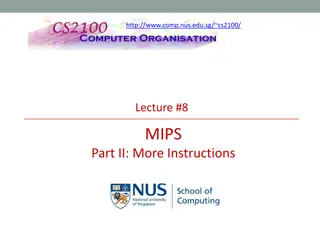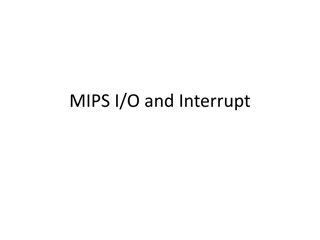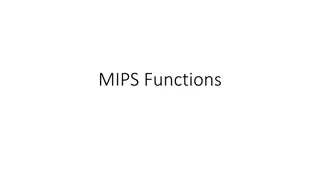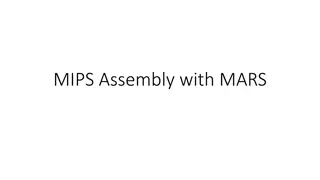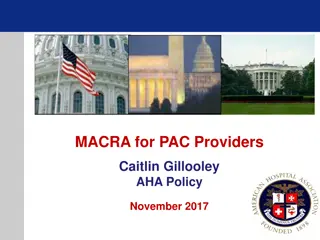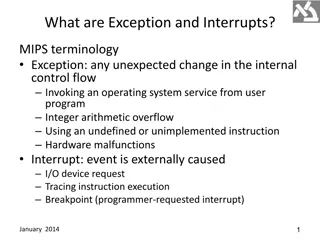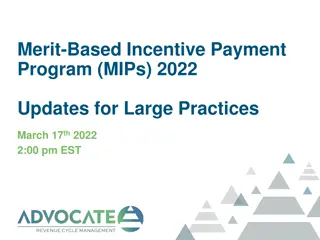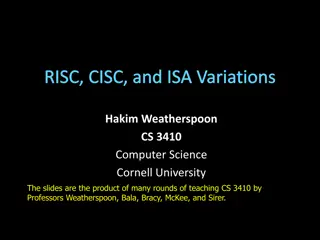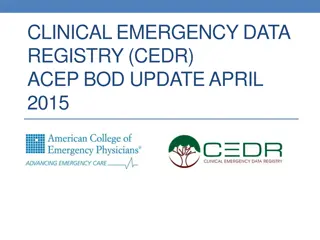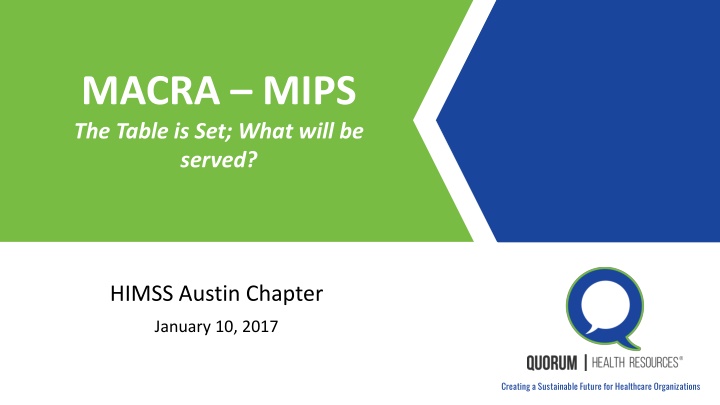
Transforming Healthcare Delivery through MACRA and MIPS Initiatives
Discover the impact of MACRA and MIPS initiatives in reshaping healthcare delivery models, focusing on quality, cost, and patient outcomes. Explore the shift towards population health management and alternative payment models for a sustainable healthcare future.
Download Presentation

Please find below an Image/Link to download the presentation.
The content on the website is provided AS IS for your information and personal use only. It may not be sold, licensed, or shared on other websites without obtaining consent from the author. If you encounter any issues during the download, it is possible that the publisher has removed the file from their server.
You are allowed to download the files provided on this website for personal or commercial use, subject to the condition that they are used lawfully. All files are the property of their respective owners.
The content on the website is provided AS IS for your information and personal use only. It may not be sold, licensed, or shared on other websites without obtaining consent from the author.
E N D
Presentation Transcript
MACRA MIPS The Table is Set; What will be served? HIMSS Austin Chapter January 10, 2017 1 Creating a Sustainable Future for Healthcare Organizations Proprietary & Confidential
New Congress Guarantees Repeal of Affordable Care Act in 2017 What does it mean? If past behavior predicts future behavior, look at the > 60 times a bill has passed the House for ACA repeal Taxes Mandates Subsidies Exchanges Medicaid expansion 2 Proprietary & Confidential
Whats not on the list? The Mantra: Better Care with Lower Cost and improved Experience MACRA and MIPS/APM s are not part of the ACA different law Pretty much all of government paid healthcare is colloquially lumped into the term Obamacare which may include more than ACA Many value-based programs including Meaningful Use started in the GW Bush Administration and a few in the Clinton Administration MACRA MIPS started January 1, 2017 3 Proprietary & Confidential
Medicare Access and CHIP Reauthorization Act of 2015 (MACRA): MACRA legislation, passed in April 2015 MACRA removed the Sustainable Growth Rate (SGR) formula Minimum Annual Physician Fee Schedule (PFS) rate updates Established two Quality Incentive Programs: o Merit Based Incentive Payment System: MIPS o Advanced Alternative Payment Models: APMs MIPS and APMs Both Intend to Improve quality and improve patient health Advance electronic medical records Control spending Provide Reimbursement Incentives for changing Clinical Practices End game: Population Health Management 4 Proprietary & Confidential
WHY MACRA/MIPS? 1. Change the way care is given and paid for by CMS 2. Change health delivery model to one based on Primary Care and Community-based care and 3. Transform Primary Care to achieve desired results of Population Health and Alternative Payment Models 4. Move to risk-based Alternative Payment Models using Population Health methodology 5 Proprietary & Confidential
With the Addition of Population Health, the Mission of Primary Care Expands Acute, Episodic Care Retail, walk-in model Integration with ED Urgent care services Chronic Care and Medical Home Patient portal, home monitoring, telehealth Managed self-care Disease Management Wellness What is the role of a primary care physician in the new organization? More manager than clinician? 6 Proprietary & Confidential
Primary Care Coordinates Population Care Advanced Clinical Practitioner Routine and Protocol Management Office Delivery Model Care coordination and communication Physician Clinical Role Complexity Patient Portal and Self Care Exceptions Management Role Strategic Role How is your Board supporting these changes in primary care delivery? How is your Board supporting physicians going through these changes? 7 Proprietary & Confidential
IMAGINE THERE S NO FEE FOR SERVICE IT S EASY IF YOU TRY 8 Proprietary & Confidential
MACRA - Medicare Access and CHIP Reauthorization Act of 2015 Changing How Physicians and other Providers Are Paid while Driving Practice Transformation Two ways to participate: MIPS (Merit Based Incentive Payment System) most practices Advanced Alternative Payment Models (APM) contracting for risk Quality Resource Utilization Clinical Practice Improvement Advancing Care Information (MU) Next generation ACO (risk) Medicare Advantage Comprehensive Primary Care Plus Patient Centered Medical Home 9 Proprietary & Confidential
MACRA MIPS Summary for HIMSS members 1. What it is : Payment Reform for Medicare Part B 2. Who it impacts: Eligible Clinicians subject to the Medicare physician fee schedule 3. IT is involved: continue Certified Electronic Health Record and Meaningful Use for physicians and other EC s 4. IT involved : support reporting for Quality, Claims and Clinical Improvement 5. IT involved : one of three imperatives for success in Population Health and risk payment methodology 10 Proprietary & Confidential
Merit Based Incentive Payment System (MIPS): Applicable to Professional Service Providers - Clinicians MIPS will apply to following Clinicians: Physicians Chiropractors Mid-level practitioners CMS will add other professionals in 2021 Medicine and osteopathy Dental surgery Podiatric medicine Optometry Physician assistants (PAs) Nurse practitioners (NPs) Clinical nurse specialist (CNS) Certified registered nurse anesthetists (CRNAs) Physical, speech and occupational therapist Audiologist Others reimbursed under Physician Fee Schedules 11 Proprietary & Confidential
Clinicians Exempt from MIPS Low CMS volume physicians (<100 patients or $30K) Non-patient facing physicians Physicians practicing at Critical Access Hospitals MIPS not applicable to RHCs and FQHCs The intention is to exclude small practices; estimated about 50% of physicians will be excluded initially. HOWEVER 12 Proprietary & Confidential
If exempt, why care about MACRA / MIPS? While CAH and RHC s are exempt from initial implementation, any provider outside of these entities will be impacted In the Alternative Payment Model, CMS is soliciting commercial payers to play under the same structures Commercial payers are likely to move to risk contracts as fast as the market will allow CMS will likely converge all payment methodology as rapidly as politically feasible Proprietary & Confidential ? 13
How does MIPS work? select measures and start 2017 A single MIPS composite performance score will factor in performance in 4 weighted performance categories: Advancing Care Information New MIPS Composite Performance Score Based on the MIPS composite performance score, physicians and practitioners will receive positive, negative, or neutral reimbursement adjustments 14 Proprietary & Confidential
Soft Launch vs. Full Launch OPTIONS: Full Year reporting period preferred maximum gain available in 2019 90 day reporting period probably neutral No reporting = certain penalty in 2019 15 Proprietary & Confidential
Submitting Data to CMS for MIPS Performance Scores Table 1: Proposed Data Submission Mechanisms for MIPS Eligible Clinicians Reporting Individually as TIN/NPI Performance Category/Submission Combinations Accepted Individual Reporting Data Submission Mechanisms Quality Claims QCDR(Qualified Clinical Data Registry) Qualified registry EHR Administrative claims (no submission required) Resource Use Administrative claims (no submission required) Advancing Care Information Attestation QCDR Qualified registry EHR CPIA Attestation QCDR Qualified registry EHR Administrative claims (if technically feasible, no submission required) 16 Proprietary & Confidential
MIPS Four Determinants of Performance Score 1. Quality Reporting (60%) Chose six metrics to report by end of 2016 for performance year 2017 Similar to PQRS use same metrics and reporting system 2. Advancing Care Information (25%) Replaces Meaningful Use Dropping CPOE and decision support requirements after 2017 Very similar to current Meaningful Use requirements 3. Clinical Practice Improvement Activities (15%) Flexible can choose from 90 options this is new o Examples include care coordination; 24/7 access 4. Resource Utilization (0% - increases in coming years with decrease weight on quality) 17 Proprietary & Confidential
MIPS Is Budget-neutral for CMS 9% 7% 5% 4% Adjustment to provider s Medicare Part B payment MAXIMUM Adjustments Adjustments -4%-5% -7%-9% 2019 2020 2021 2022 onward 18 Proprietary & Confidential
MIPS advancing care information objectives and measures Replaces Meaningful Use as of calendar 2018 (note MIPS applies to eligible providers and not to hospital participation in Medicare EHR Incentive program or Medicaid EHR Incentive Program) Six Criteria 1. 2. 3. 4. Protect Patient Health Information Security Risk Analysis Electronic Prescribing Patient Electronic Access Patient Access, Patient-specific education Coordination of Care Through Patient Engagement View/Download/Transmit, Secure Messaging, Patient Generated Health Data Health Information Exchange Patient Record Exchange, Request/Accept Patient Care Record, Clinical Information Reconciliation Public Health and Clinical Data Registry Reporting Immunization Registry Reporting 5. 6. 19 Proprietary & Confidential
Advancing Care Information To-Dos For the period Jan 1, 2017 to December 31, 2017, clinician must: Use 2014 or 2015 Edition Certified EHR Report on either eight stage 2 or six stage 3 advancing care information objectives and measures Attest to their cooperation in good faith with the surveillance and ONC direct review of the EHR Attest to their support for health information exchange and the prevention of information blocking 20 Proprietary & Confidential
MIPS Proposed Rule: Advancing Care Information Scoring and Measures Table 9: Sample Performance Score Coordination of Care Through Patient Engagement Objectives Patient Electronic Access Health Information Exchange (HIE) Patient- Specific Education Patient Care Record Exchange Clinical Information Reconciliation Secure Messaging Patient-Generated health Data Request/Accept Patient Care Record Measures Patient Access VDT 95% Performance Rate Score 65% 57% 33% 31% 38% 25% 24% Percentage Points Earned 9.5% 6.5% 3.3% 3.1% 2.5% 2.1% 3.8% 5.7% Performance Score = 36.6 percent, sum of all above Note: No points scored based on score relative to national benchmarks or scoring due to improvement from prior periods 21 Proprietary & Confidential
ACI scoring Base Score measure support all 4 Advancing Care Information Objectives: 1. Protect Patient Health Information 2. Electronic Prescribing 3. Patient Electronic Access 4. Health Information Exchange 22 Proprietary & Confidential
23 Proprietary & Confidential
MIPS Proposed Rule: Measurement Categories Quality measures fall under five quality domains: Clinical care Safety Care coordination Patient and care giver experience Population health and management 24 Proprietary & Confidential
Quality Reporting Domain: Scoring Highlights Based Upon Performance to national benchmarks Score on each measure reported Low volume thresholds Score based on decile basis Bonus Points 25 Proprietary & Confidential
MIPS Proposed Rule: Clinical Process Improvement Activities (CPIA) Domain Defined Activity Total Activities High Weight Med. Weight Comment on High Expanded Practice Access 4 1 3 24/7 Practice Access Population Management 16 4 12 Anticoagulation Program, for ex Care Coordination 14 1 13 In CMS TCPI demonstration Beneficiary Engagement 24 1 23 Patient Survey, follow up and improvement plan Patient Safety & Practice Assessment 21 1 20 Prescription Drug Monitoring Achieving Health Equity 5 1 4 Seeing new Medicaid Patients Emergency Response & Preparedness 3 0 3 Integrated Behavioral & Mental Health 8 2 6 Integrated behavioral health for dementia, chronic condition etc. What does this table tell us if anything? 26 Proprietary & Confidential
Care Coordination Some Common Features per AHRQ Examples of broad care coordination approaches include: Teamwork Care management Medication management Health information technology Patient-centered medical home Examples of specific care coordination activities include: Establishing accountability and agreeing on responsibility Communicating/sharing knowledge Helping with transitions of care Assessing patient needs and goals Creating a proactive care plan Monitoring and follow-up, including responding to changes in patients' needs Supporting patients' self-management goals Linking to community resources Working to align resources with patient and population needs 27 Proprietary & Confidential
Am I ready for MIPS or non-risk ACO? Must Haves Practice Quality Reporting Clinical Practice Improvement Physician Practices Practice IT Systems Physician led Productivity Financial Stable core Provider compensation methodology Use EMR and PMS data to drive results Growth strategy PQRS Meaningful Use VBM aware Internal reporting to provider level Use data for quality, continuity, access, satisfaction improvement EMR-PMS certified- updated Physicians actively using and improving systems and reports Single data view- interoperable Provider level data Physician led Access Population Management Care Coordination Patient engagement Safety Telemedicine 28 Proprietary & Confidential
Have Systems, Analytics, and Reporting for Risk Contract Support Basic functions Examples Unified EHR and business systems Single platform or information exchange capability; single view data to provider level Business analytics Claims data request and management Reporting structured and ad hoc Data warehouse; clinical quality data aggregation; cost and quality dashboards; resource utilization Registries-clinical analytics Population and condition; standard risk adjustment methodology Clinical Integration Single view clinical data Patient Access View EMR; eRx; requests 29 Proprietary & Confidential
30 Proprietary & Confidential
31 Proprietary & Confidential
A practical way to think of compliance with MIPS If you have a CHERT certified EHR updated to 2015, you should have the capability for MIPS reporting; some specialty components may not be available If you have been doing and are up to date with PQRS reporting on all your EC s, you should be ready for MIPS Quality reporting If you have been participating in an ACO, check to see if you already have a path to MIPS If you have been doing and are up to date with Meaningful Use reporting and attestations, you should ready for MIPS Advancing Care Information Resource utilization requires no additional filing besides claims filing Clinical Practice Improvement activities are new but should fit with your Quality practice improvement program 32 Proprietary & Confidential
What do I do if Im not ready for MIPS? If you think you may be exempt from MIPS, make sure before you blow it off If you are not doing PQRS, sign up immediately and start becoming familiar with reporting methods If you have been participating in PQRS and VM programs look at your reports (QRUR Quality and resource use report and PQRS feedback report) If you are not reporting, choose a reporting mechanism Contact your EHR vendor to understand their capability and plans for compliance 33 Proprietary & Confidential
MACRA resources: Centers for Medicare & Medicaid Service (CMS) Medicare Access and CHIP Reauthorization Act (MACRA) proposed rule (pdf) CMS MACRA web site CMS Resources: Fact sheets, webinars, slide decks, and more Texas Medical Association MACRA resource center American Medical Association MACRA resource center National medical specialty societies list with MACRA information Signup for CMS MACRA Quality Payment Program email updates CMS Physician Quality Reporting System (PQRS) feedback reports CMS Value-Based Payment Modifier Program quality and resource use reports (QRURs) 34 Proprietary & Confidential
Creating a Sustainable Future for Healthcare Organizations 35 Proprietary & Confidential

